Mark Rober and Bard Build the World’s Most Accurate Paper Airplane
In this exciting collaboration between Mark Rober, a popular science YouTuber, and Bard, a large language model from Google AI, they set out to do what might seem impossible: build the world’s most accurate paper airplane.
The video begins with Mark Rober approaching Bard with a challenge: come up with an idea for a Mark Rober video that surpasses even his usual science-focused content. Bard, ever up for a challenge, proposes building the world’s most accurate paper airplane. Intrigued, Mark Rober agrees, and the two embark on a fascinating journey of design, optimization, and testing.
Their quest starts with exploring various paper airplane designs, from the classic glider to the sleek Concord and the unconventional Canard. After careful consideration, they choose the Concord as the most promising candidate for accuracy.
But simply choosing the right design isn’t enough. To achieve peak performance, Mark Rober and Bard meticulously optimize the Concord, enlarging the wings and tail for better stability and precision, and sharpening the folds for a cleaner flight path.
Now comes the moment of truth: testing the airplane’s accuracy in a visually captivating and engaging environment. Mark Rober doesn’t hold back, transforming his backyard into a testing ground filled with dramatic fog, dazzling sparklers, and even a grand finale of miniature fireworks. The ultimate test, however, awaits – a fiery ring that the airplane must fly through to claim the title of the world’s most accurate.
With a practiced throw, Mark Rober sends the paper airplane soaring. It gracefully navigates the obstacle course, its wings slicing through the air with remarkable precision. And then, the defining moment: the airplane sails through the ring of fire, emerging unscathed and solidifying its place in paper airplane history.
Mark Rober’s excitement is palpable as he celebrates his and Bard’s accomplishment. Throughout the video, he expresses his admiration for Bard’s ability to not only generate the idea but also actively participate in the design and testing process.
This video is more than just a testament to Mark Rober’s ingenuity and Bard’s technological prowess; it’s a celebration of the power of collaboration. It shows how humans and AI, when working together, can achieve remarkable things, pushing the boundaries of creativity and innovation.
Beyond the Accuracy: Additional Insights from the Video
The video is packed with interesting tidbits that add depth to the experience. Here are a few noteworthy details:
- Material Matters: Instead of traditional paper, Mark Rober opted for foam board to construct the airplane. This choice provided crucial advantages in terms of weight and durability, allowing the airplane to withstand multiple throws and tests.
- Size Matters Too: The airplane boasted an impressive wingspan of 6 feet, contributing significantly to its stable and accurate flight.
- Sparking Spectacle: The ring of fire, a key element of the final test, was meticulously crafted using sparklers and fireworks, adding a touch of drama and excitement to the big reveal.
- A Collaborative Feat: The entire project, from conception to execution, took Mark Rober and Bard a mere 3 weeks, showcasing the efficiency and effectiveness of their teamwork.
I hope this blog post has captured the essence of Mark Rober and Bard’s incredible feat in creating the world’s most accurate paper airplane. It’s a story that not only entertains but also inspires, reminding us of the boundless possibilities that arise when human ingenuity meets the power of artificial intelligence.
So, the next time you see a paper airplane soaring through the air, remember Mark Rober and Bard’s remarkable collaboration, and perhaps be inspired to take on your own science experiment or creative challenge. You never know what amazing things you might achieve!






